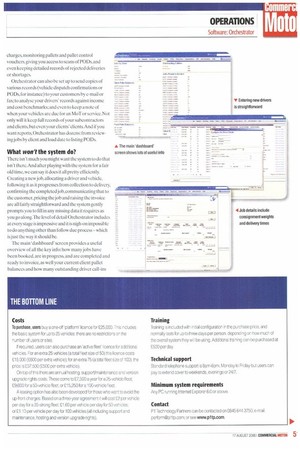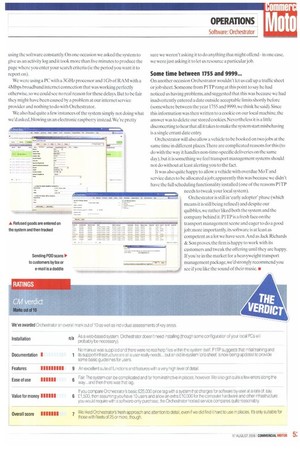0 11C
Page 50

Page 51

Page 52

Page 53

If you've noticed an error in this article please click here to report it so we can fix it.
STRAL EUVRES
Managing a transport operation is like
concluding an orchestra — you have to get everyone playing the same tune, then keep them in time. So does the Orchestrator management system produce sweet music?
Robin Meczes has been taking notes...
Orchestrating your staff, vehicles, drivers, subcontractors and clients in a smooth and efficient way is a challenge for any firm, but especially for the medium to large outfits — the more you've got to manage. the trickier it gets.That's why Orchestrator, a new transport management system from P1 Technology Partners, is aimed squarely at those with fleets of 25 and over.
The system has been developed over the past couple of years with the help of Jack Richards & Son (see user views panel). I [ is entirely web-based, so all you need to use it is a computer with intemet access. The software itself, along with your data, is held on a central server owned and run by P1TP This eliminates any hardware purchase and maintenance issues, and ensures that your data is always backed up.
It also means you can access the system from any internet-enabled PC, rather than being restricted to specific access points in specific locations, as with most locally installed software.
But enough about the IT infrastructure for now. What can Orchestrator do, and how good is it?
The short answer to the first question is that it's a multi-user, multi-site transport management package, with all that entails: taking initial job bookings from customers, allocating vehicles and drivers to them, monitoring planned vs actual collection and delivery times, and producing invoices.
But that is to gloss over the many functions and features of Orchestrator.These include: tracking outstanding call-ins from and other communications with your drivers; keeping an eye on demurrage charges, monitoring pallets and pallet control vouchers, giving you access to scans of PODs, and even keeping detailed records of rejected deliveries or shortages.
Orchestrator can also be set up to send copies of various records (vehicle dispatch confirmations or PODs, for instance) to your customers by e-mail or fax; to analyse your drivers' records against income and cost benchmarks; and even to keep a note of when your vehicles are due loran MoT or service. Not only will it keep full records of your subcontractors and clients, but even your clients' clients. And if you want reports, Orchestrator has dozens: from reviewing jobs by client and load date to listing PODs.
What won't the system do?
There isn't much you might want the system to do that isn't there. And after playing with the system for a fair old time, we can say it does it all pretty efficiently. Creating a new job, allocating a driver and vehicle, following it as it progresses from collection to delivery, confirming the completed job, communicating that to the customer, pricing the job and raising the invoice are all fairly straightforward and the system gently prompts you to fill in any missing data it requires as you go along.The level of detail Orchestrator includes at every stage is impressive and it is nigh-on impossible to do anything other than follow due process— which is just the way it should be.
The main 'dashboard' screen provides a useful overview of all the key info: how many jobs have been booked, are in progress, and are completed and ready to invoice, as well your current client pallet balances and how many outstanding driver call-ins need chasing up, for example.The dashboard also incorporates a series of pull-down menus giving you access to the mass of other detail stored in the system. It's easy enough to call up lists of jobs for particular periods of time, and jobs are colour-coded so you can quickly see which have been booked or planned: which are in progress or complete; which are ready to invoice or already invoiced; even any which have been cancelled.You can also see which jobs are being handled by which depot,who planned each-job and what resources have been allocated to it.
Add to all this the fact that Orchestrator can be integrat e..i ed with other packages (to pull in jobs from other orderprocessing systems, for exampleuseful if you are part of a consortium with its own central software). It's currently being updated in a number of ways, not least to accommodate GPS data, drivers' hours calculations, automatic demurrage calculations and electronic PODs.The result is a pretty accomplished system.
There were, however, some things we weren't too keen on. Perhaps our most serious complaint is that we experienced significant 'lag' when using the system as our request found its way back to P1TP's server and the results were returned to us. Some requests took up to 10 seconds to be processed not a lot in itself, but niggly when you're
using the software constantly. On one occasion we asked the system to give us an activity log and it took more than five minutes to produce the page where you enter your search criteria (ie the period you want it to report on).
We were using a PC with a 3G1-1/ processor and 1Gb of RAM with a 4Mbps broadband interact connection that was working perfectly otherwise, so we could see no real reason for these delays. But to be fair they might have been caused by a problem at our Internet service provider and nothing to do with Orchestrator.
We also had quite a few instances of the system simply not doing what we'd asked, blowing us an electronic raspberry instead. We're pretty sure we weren't asking it to do anything that might offend in one case, we were just asking it to let us resource a particularjob.
Some time between 1755 and 9999...
On another occasion Orchestrator wouldn't let us call up a traffic sheet or job sheet. Someone from P1TP rang at this point to say he had noticed us having problems, and suggested that this was because we had inadvertently entered a date outside acceptable limits shortly before (somewhere between the year 1755 and 9999, we think he said). Since this information was then written to a cookie on our local machine, the answer was to delete our stored cookies. Nevertheless it is a little disconcerting to hear that all it takes to make the system start misbehaving is a single errant date entry.
Orchestrator will also allow a vehicle to be booked on two jobs at the same time in different places.There are complicated reasons for this (to do with the way it handles non-time-specific deliveries on the same day), but it is something we feel transport management systems should not do without at least alerting you to the fact.
It was also quite happy to allow a vehicle with overdue MoT and service dates to be allocated a job: apparently this was because we didn't have the full scheduling functionality installed (one of the reasons PI TP needs to tweak your local system).
Orchestrator is still in 'early adopter' phase (which means it is still being refined) and despite our quibbles, we rather liked both the system and the company behind it. P1TP is a fresh face on the transport management scene and eager to do a good job: more importantly. its software is at least as competent as a lot we have seen. And as Jack Richards & Son proves, the firm is happy to work with its customers and tweak the offering until they are happy. If you're in the market for a heavyweight transport management package, we'd strongly recommend you see if you like the sound of their music. •










































































































































































































